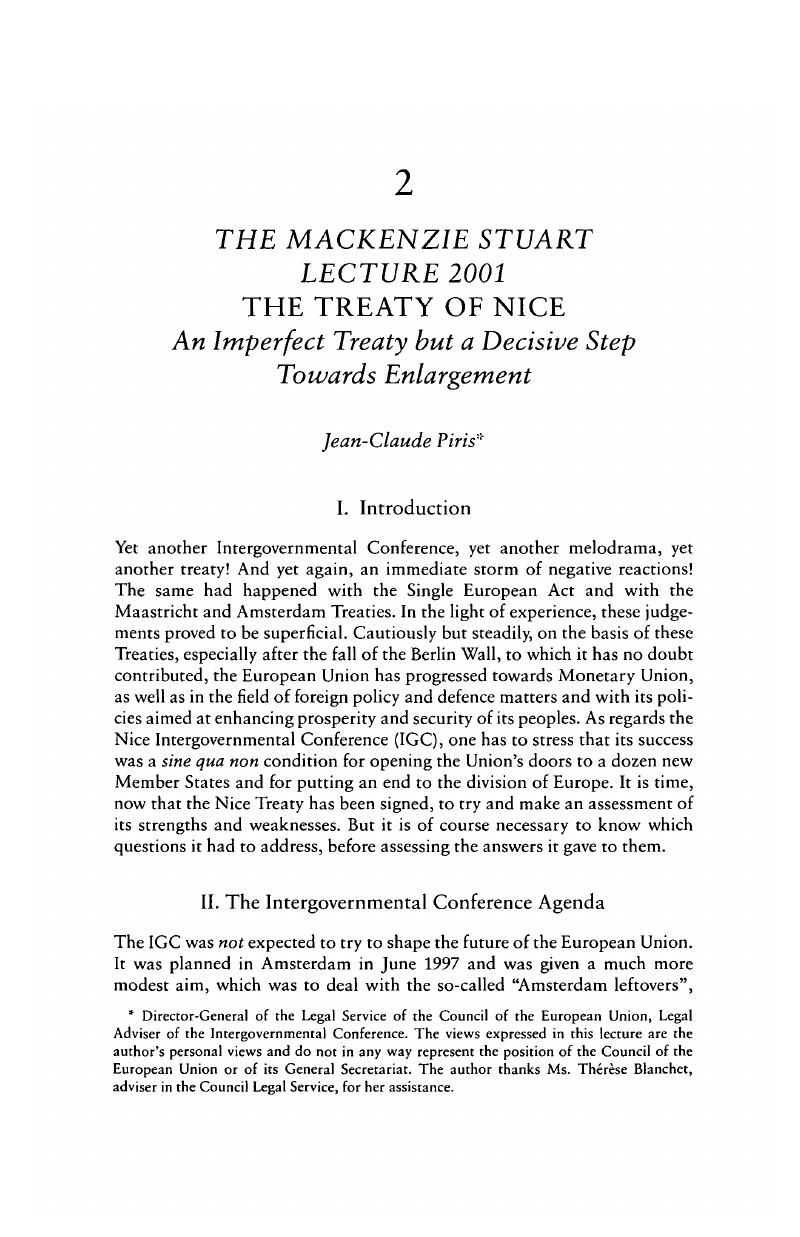No CrossRef data available.
Article contents
The Mackenzie Stuart Lecture 2001: The Treaty of Nice: An Imperfect Treaty but a Decisive Step Towards Enlargement
Published online by Cambridge University Press: 27 October 2017
Abstract

- Type
- Oration
- Information
- Copyright
- Copyright © Centre for European Legal Studies, Faculty of Law, University of Cambridge 2000
References
1 In addition, in the law authorising the ratification of the Amsterdam Treaty, the French Parliament inserted a provision under which the French Republic expressed its determination to see, beyond Amsterdam, substantial progress be made in institutional reform in order to make the Union function more efficiently and more democratically, before the conclusion of the first enlargement negotiations (see Law n° 99-229 of 23 March 1999, French Republic OJ of 25 March 1999, 4463).
2 I.e. Cyprus, Hungary, Poland, Estonia, the Czech Republic and Slovenia, usually referred to as “the Luxembourg Group” because the decision to start enlargement negotiations with these States was taken at the European Council in Luxembourg in December 1997 (see Presidency Conclusions, Luxembourg, 12 and 13 December 1997, para. 27).
3 See Presidency Conclusions, Cologne, 3 and 4 June 1999, para. 53.
4 See Presidency Conclusions, Helsinki, 10 and 11 December 1999, paras. 15 and 16.
5 See Presidency Conclusions, Santa Maria da Feira, 19 and 20 June 2000, para. 3.
6 I.e. Romania, Slovakia, Latvia, Lithuania, Bulgaria and Malta, often called “the Helsinki Group” because the decision to start enlargement negotiations with these States was taken in the European Council in Helsinki in December 1999 (see Presidency Conclusions, Helsinki, 10 and 11 December 1999, para. 10).
7 Originally, in an EU of six Member States (EU-6), out of a total of 17 votes, the three big Member States had four votes each, the two medium sized ones (Belgium and the Netherlands) had two votes each and Luxembourg had one vote. The qualified majority was fixed at 12, the blocking minority being six (i.e. the three big Member States could outvote the smaller ones who together had only five votes). This feature would disappear in EU-9 where out of a total of 58 votes the four big Member States had ten votes each, the four medium sized ones (Belgium and the Netherlands, on the one hand, and Denmark and Ireland, on the other) had, respectively, five and three votes each and Luxembourg had two votes. The qualified majority was fixed at 41, the blocking minority being 18. The four big Member States (40 votes together) could no longer achieve a qualified majority, the five medium and small sized Member States (18 votes together) could now block a decision and the simple majority (five members) became an inbuilt element within the qualified majority (i.e. it took defacto a min imum of five members to reach a qualified majority). These characteristics remained roughly the same until now. The qualified majority threshold remained at about 70-71%. The share of big Member States in the votes decrease from about 70% in EU-6, EU-9 and EU-10, to 63% in EU-12, down to 55% in EU-15. Conversely, the level of population contained in qualified majority fell from 68-70% to 63% in EU-12 down to 58% in EU-15. For an illustration of the present situation, see Table 1 hereafter.
8 1999; source: Eurostat population data.
9 Share in 2000 budget, source: EU Council General Secretariat.
10 GDP at market prices for 1999, source: Eurostat.
11 The qualified majority may be reached by 8 Member States (i.e. the 5 big Member States plus 2 big medium sized ones and one with 4 votes). The simple majority is thus inbuilt in the system.
12 See Table 2 hereafter.
13 See Table 3 hereafter.
14 This is due to the fact that the 62% population threshold introduces an additional blocking minority of 39 % of the population, which may be reached by three big Member States only if one of them is Germany. This gives Germany the equivalent of four votes since three big Member States have otherwise 87 votes, i.e. short of four votes to reach the blocking minority of 91. In EU-27, Germany will represent 17% of the population, while the United Kingdom, France and Italy will represent 12% each (Spain and Poland 8% each). Germany plus two of the big States may reach the population blocking minority of 39%, while the United Kingdom, France and Italy alone reach only 36% of the population (see Table 3).
15 The Declaration reads as follows:
“Insofar as all candidate countries listed in the declaration (. . .) have not yet acceded to the Union when the new vote weighting takes effect (I January 2005), the threshold for a qualified majority will move, according to the pace of accessions, from a percentage below the current one to a maximum of 73.4%. When all the candidate countries mentioned above have acceded, the blocking minority, in a Union of 27, will be raised to 91 votes, and the qualified majority threshold resulting from the table (...) will be automatically adjusted accordingly”
16 1999; source: Eurostat population data.
17 Theoretically, the qualified majority may be reached by 13 Member States (the 6 big plus the 7 biggest medium sized), i.e. less than the simple majority (14). However, it is most probable that, in real life, it will always be inbuilt in the qualified majority.
18 2000; source: Eurostat population data.
19 The qualified majority may be reached by 8 Member States (the 6 big plus the 7 biggest medium sized). The simple majority is thus inbuilt in the qualified majority.
20 For a complete picture of the results, see Table 4 hereafter.
21 See Table 5 hereafter.
22 This will begin with the Danish Presidency (second half of 2002).
- 1
- Cited by


